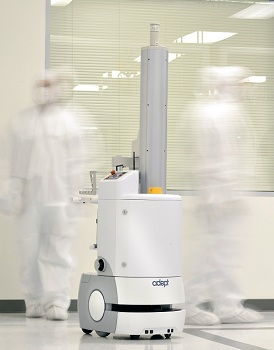Let me tell you about Lynx, a little robot I met a few weeks ago. Made by Adept Technology Inc., Lynx is a self-navigating autonomous indoor vehicle (AIV) capable of moving material from point to point through confined passageways and locations with people and obstacles.
Before I saw Lynx in action—courtesy of David Cappellini, midwest regional sales manager, and Martin DiMarzio, applications engineer for Adept Technology Inc. —I believed strongly that no robot could be just another worker out on the plant floor. Now I know better.
“An AIV is truly autonomous, meaning it requires no infrastructure at all,” explains Cappellini. “There is no need for floor magnets or navigational beacons. All that’s needed is a natural environment.”
What impresses me most about Lynx (named after the very mobile wildcat) is its ability to find an alternate route to its destination without human intervention. Most autonomous guided vehicles (AGVs) function like an airport shuttle that must stop at various designated points before driving a passenger to his hotel destination, notes Cappellini. The Lynx, in contrast, is similar to a taxi that goes directly to the hotel via the fastest route.
Determining the robot’s route is a simple five-step process. An operator plugs a joystick into Lynx’s left side, starts up the robot, presses the joystick Goal button and opens MobilePlanner software on his iPad, PC or PLC. As he walks, lasers at the sides of Lynx gather data (within a 250-degree range) and generate a map that is displayed on the computer or mobile device.
This map shows a wide line (where the AIV has traveled) and various nearby markings that indicate different objects or people present within the coverage area. According to DiMarzio, the operator then uses MobilePlanner to clean up the map by delineating Lynx’s operating parameters and forbidden areas. Both areas must be clearly defined to optimize robot productivity.
Cappellini says nearly 35 manufacturers worldwide are using one or more Lynx in their factories. Several companies have found it more cost-effective to have the robot bring the exact number of parts needed for a project to a workstation—rather than just placing nearby a large skid of parts that may not all be needed.
Other manufacturers, including Global Foundries Inc., have mounted a vision-equipped robotic arm on the AIV. The arm has selected and delivered tools, packages and information to workers within cleanrooms at a Singapore semiconductor fabrication plant since early 2013.
Companies also like the robot’s built-in HMI panel that enables a worker to send Lynx to another location with the single push of a button. Equally important, any worker that interacts with the robot can use MobileEyes software for real-time monitoring of the robot’s present location and planned destinations.
Personally, I’m very impressed with the robot’s fast movement (1.8 mps), long run time (13 hours on a full charge) and high payload capacity (60 kilograms). I also think it’s cool that some companies have made Lynx more interactive by equipping it with an audio device that says greetings to fellow workers or plays music.
“When the robot’s mapped area is obscured—for whatever reason—an acuity feature activates and uses the light from above to direct the AIV along its proper path,” explains Cappellini. “You can even program how many times Lynx tries a path before realizing it isn’t feasible.”
What is feasible is the ability of robots to be collaborative and friendly on and off the plant floor. Now I know that first-hand.


Recent Comments
Helpful for Trainees
Cable Assembly Manufacturers
Huawei for manufacturing?
should have a scanner and then 3D print the repair
IPC-A-610 and IPC-j-std-001